Introduction of Chaplin卓别林生平介绍英文版
- 格式:docx
- 大小:13.00 KB
- 文档页数:2
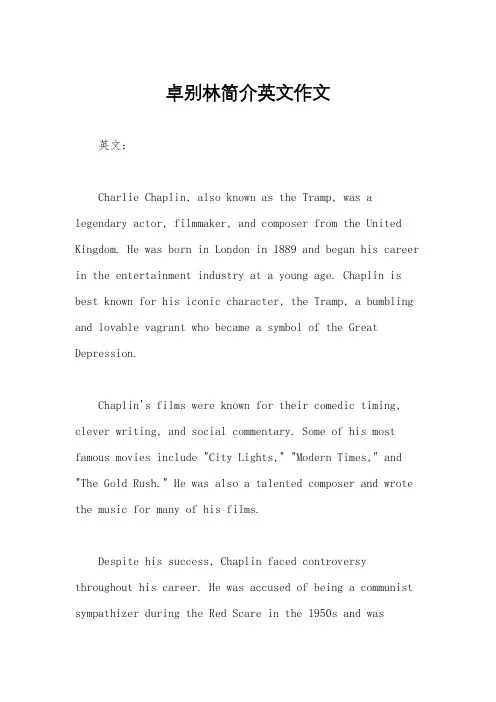
卓别林简介英文作文英文:Charlie Chaplin, also known as the Tramp, was a legendary actor, filmmaker, and composer from the United Kingdom. He was born in London in 1889 and began his career in the entertainment industry at a young age. Chaplin is best known for his iconic character, the Tramp, a bumbling and lovable vagrant who became a symbol of the Great Depression.Chaplin's films were known for their comedic timing, clever writing, and social commentary. Some of his most famous movies include "City Lights," "Modern Times," and "The Gold Rush." He was also a talented composer and wrote the music for many of his films.Despite his success, Chaplin faced controversy throughout his career. He was accused of being a communist sympathizer during the Red Scare in the 1950s and waseventually forced to leave the United States. However, he continued to make films and was awarded an honorary Oscar in 1972 for his contributions to the film industry.Overall, Charlie Chaplin's legacy as a filmmaker and entertainer has had a lasting impact on popular culture. His films continue to be beloved by audiences around the world and his influence can be seen in the work of many modern filmmakers.中文:查理·卓别林,也被称为小流浪汉,是英国一位传奇的演员、电影制片人和作曲家。
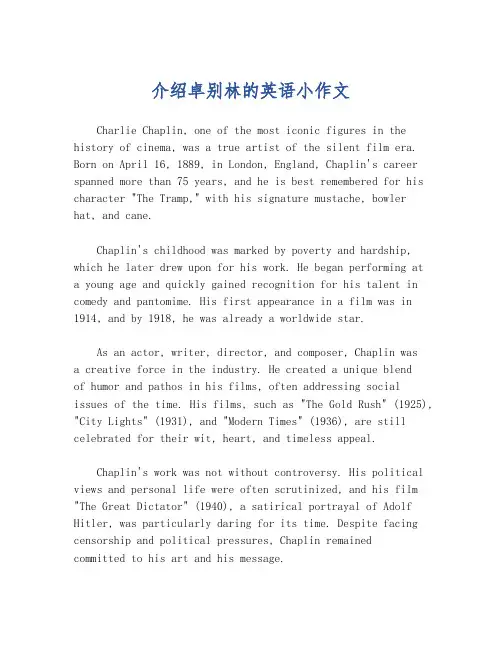
介绍卓别林的英语小作文Charlie Chaplin, one of the most iconic figures in the history of cinema, was a true artist of the silent film era. Born on April 16, 1889, in London, England, Chaplin's career spanned more than 75 years, and he is best remembered for his character "The Tramp," with his signature mustache, bowler hat, and cane.Chaplin's childhood was marked by poverty and hardship, which he later drew upon for his work. He began performing at a young age and quickly gained recognition for his talent in comedy and pantomime. His first appearance in a film was in 1914, and by 1918, he was already a worldwide star.As an actor, writer, director, and composer, Chaplin wasa creative force in the industry. He created a unique blendof humor and pathos in his films, often addressing social issues of the time. His films, such as "The Gold Rush" (1925), "City Lights" (1931), and "Modern Times" (1936), are still celebrated for their wit, heart, and timeless appeal.Chaplin's work was not without controversy. His political views and personal life were often scrutinized, and his film "The Great Dictator" (1940), a satirical portrayal of Adolf Hitler, was particularly daring for its time. Despite facing censorship and political pressures, Chaplin remainedcommitted to his art and his message.In his later years, Chaplin was recognized for his contributions to the arts. He received numerous awards, including an Honorary Oscar in 1972 for "the incalculable effect he has had in making motion pictures the art form of this century." Chaplin passed away on December 25, 1977, but his legacy lives on through the timeless films he created and the indelible character of The Tramp, which continues to inspire and entertain audiences around the world.。
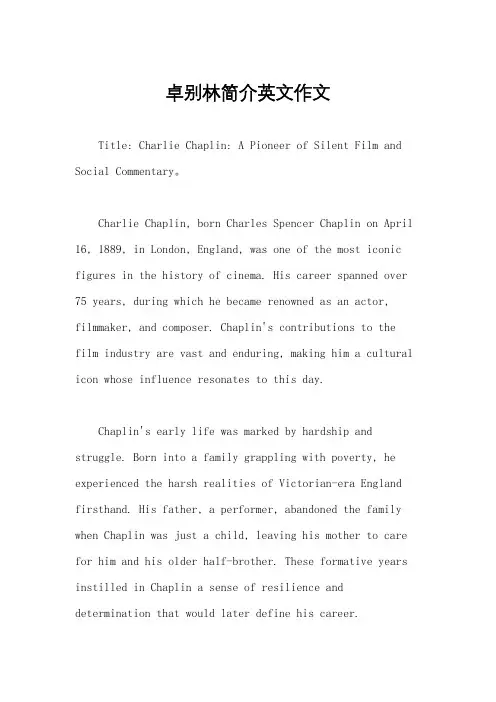
卓别林简介英文作文Title: Charlie Chaplin: A Pioneer of Silent Film and Social Commentary。
Charlie Chaplin, born Charles Spencer Chaplin on April 16, 1889, in London, England, was one of the most iconic figures in the history of cinema. His career spanned over 75 years, during which he became renowned as an actor, filmmaker, and composer. Chaplin's contributions to the film industry are vast and enduring, making him a cultural icon whose influence resonates to this day.Chaplin's early life was marked by hardship and struggle. Born into a family grappling with poverty, he experienced the harsh realities of Victorian-era England firsthand. His father, a performer, abandoned the family when Chaplin was just a child, leaving his mother to care for him and his older half-brother. These formative years instilled in Chaplin a sense of resilience and determination that would later define his career.At the age of 19, Chaplin began performing in music halls, where he developed his skills as a comedic actor. His talent soon caught the attention of Fred Karno, a prominent theater impresario, who hired Chaplin to join his comedy troupe. It was during this time that Chaplin honed his craft and developed his iconic persona, the Tramp.In 1913, Chaplin was recruited by Mack Sennett to work for Keystone Studios in Hollywood. It was here that he created some of his most memorable early films, including "The Kid" and "The Gold Rush." Chaplin's character of the Tramp, with his trademark bowler hat, cane, and mustache, became synonymous with silent comedy and endeared him to audiences around the world.What set Chaplin apart from his contemporaries was not only his comedic talent but also his ability to infuse his films with social commentary. At a time when silent cinema was dominated by slapstick and sight gags, Chaplin dared to address serious issues such as poverty, inequality, and the plight of the working class. Films like "Modern Times" and"The Great Dictator" showcased Chaplin's outspokenpolitical views and cemented his reputation as more than just a comedian but also a thoughtful commentator on the human condition.Despite his immense success, Chaplin's career was not without controversy. His personal life, marked by tumultuous relationships and scandalous headlines, often overshadowed his professional achievements. In 1940, amidst accusations of communist sympathies and moral misconduct, Chaplin faced increasing scrutiny from the US government, culminating in his decision to leave the country and settle in Switzerland.However, even in exile, Chaplin continued to create films that captivated audiences and challenged societal norms. His later works, such as "Limelight" and "A King in New York," explored themes of aging, fame, and the alienation of modern life. Although these films were not as commercially successful as his earlier efforts, they demonstrated Chaplin's evolution as an artist and his unwavering commitment to his craft.Charlie Chaplin's influence on cinema cannot be overstated. His innovative techniques, timeless humor, and poignant storytelling continue to inspire filmmakers and entertain audiences worldwide. Beyond his contributions to the art of film, Chaplin's legacy lives on as a symbol of resilience, creativity, and the enduring power of laughter.。
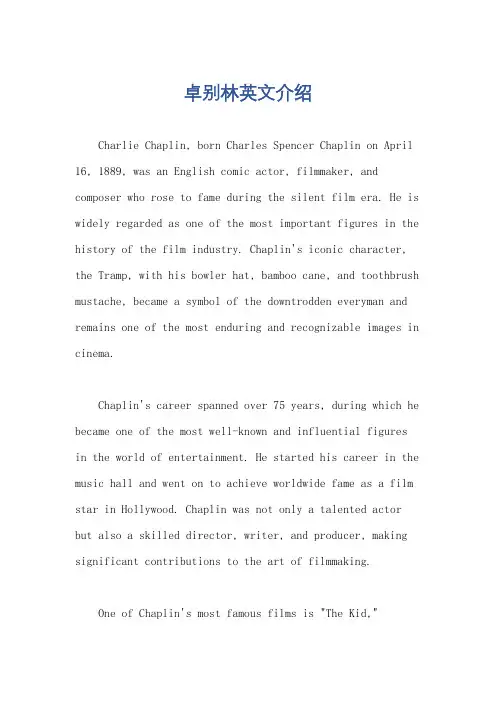
卓别林英文介绍Charlie Chaplin, born Charles Spencer Chaplin on April 16, 1889, was an English comic actor, filmmaker, and composer who rose to fame during the silent film era. He is widely regarded as one of the most important figures in the history of the film industry. Chaplin's iconic character, the Tramp, with his bowler hat, bamboo cane, and toothbrush mustache, became a symbol of the downtrodden everyman and remains one of the most enduring and recognizable images in cinema.Chaplin's career spanned over 75 years, during which he became one of the most well-known and influential figuresin the world of entertainment. He started his career in the music hall and went on to achieve worldwide fame as a film star in Hollywood. Chaplin was not only a talented actor but also a skilled director, writer, and producer, making significant contributions to the art of filmmaking.One of Chaplin's most famous films is "The Kid,"released in 1921, which he directed, produced, and starred in. The film tells the story of a tramp who finds an abandoned baby and raises him as his own. "The Kid" was a critical and commercial success and solidified Chaplin's reputation as a master filmmaker. Another one of his iconic films is "City Lights," released in 1931, which is considered one of the greatest films ever made. In this film, Chaplin's Tramp character falls in love with a blind flower girl and goes to great lengths to help her regain her sight.Despite his success in the film industry, Chaplin's personal life was marked by controversy and scandal. He was married four times and had numerous affairs, which often made headlines in the tabloids. Chaplin was also known for his left-wing political views, which led to accusations of being a communist sympathizer during the anti-communist hysteria of the 1950s. In 1952, he was barred from re-entering the United States after a trip abroad, which prompted him to settle in Switzerland, where he spent the rest of his life.In conclusion, Charlie Chaplin was a groundbreaking and influential figure in the world of entertainment, whose legacy continues to resonate to this day. His timeless films, iconic characters, and innovative filmmaking techniques have left an indelible mark on the history of cinema. Despite the controversies that surrounded his personal life, Chaplin's contributions to the art of filmmaking are undeniable, and he will always be remembered as one of the greatest talents to have ever graced the silver screen.。
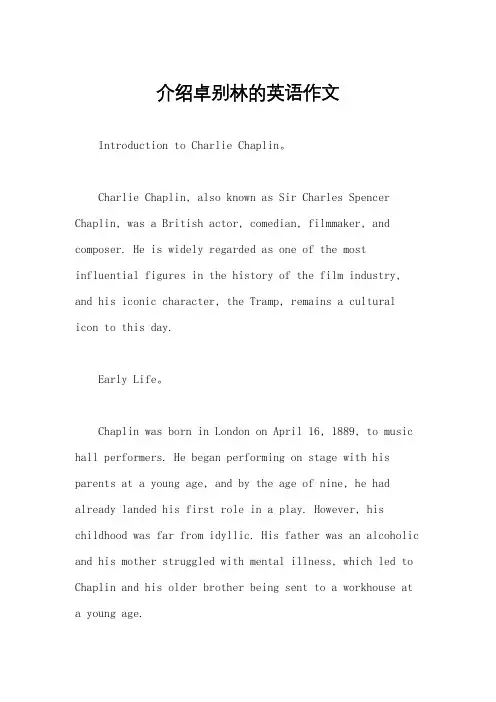
介绍卓别林的英语作文Introduction to Charlie Chaplin。
Charlie Chaplin, also known as Sir Charles Spencer Chaplin, was a British actor, comedian, filmmaker, and composer. He is widely regarded as one of the most influential figures in the history of the film industry, and his iconic character, the Tramp, remains a cultural icon to this day.Early Life。
Chaplin was born in London on April 16, 1889, to music hall performers. He began performing on stage with his parents at a young age, and by the age of nine, he had already landed his first role in a play. However, his childhood was far from idyllic. His father was an alcoholic and his mother struggled with mental illness, which led to Chaplin and his older brother being sent to a workhouse at a young age.Career。
Chaplin's big break came when he was signed to Keystone Studios in 1913. It was here that he created the character of the Tramp, a lovable but down-on-his-luck vagrant who became his most famous creation. The Tramp appeared in many of Chaplin's films, including "The Kid" (1921), "City Lights" (1931), and "Modern Times" (1936).Chaplin's films were hugely popular and he quickly became one of the biggest stars of the silent film era. However, his success was not without controversy. In the 1940s, he was accused of being a communist sympathizer and was forced to leave the United States. He eventuallysettled in Switzerland, where he lived until his death in 1977.Legacy。
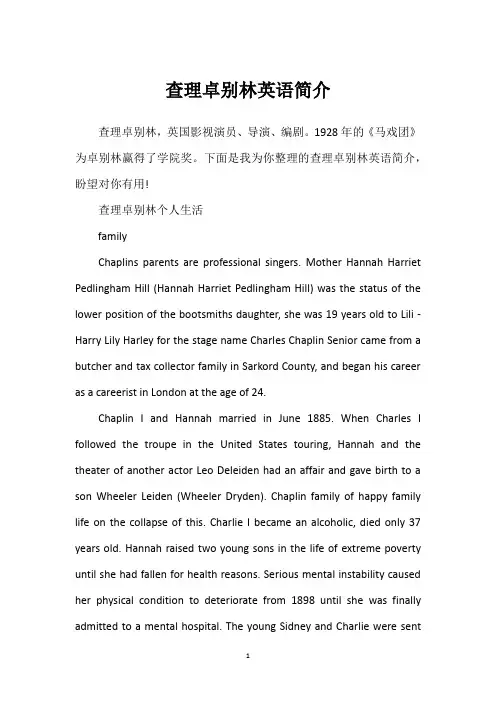
查理卓别林英语简介查理卓别林,英国影视演员、导演、编剧。
1928年的《马戏团》为卓别林赢得了学院奖。
下面是我为你整理的查理卓别林英语简介,盼望对你有用!查理卓别林个人生活familyChaplins parents are professional singers. Mother Hannah Harriet Pedlingham Hill (Hannah Harriet Pedlingham Hill) was the status of the lower position of the bootsmiths daughter, she was 19 years old to Lili -Harry Lily Harley for the stage name Charles Chaplin Senior came from a butcher and tax collector family in Sarkord County, and began his career as a careerist in London at the age of 24.Chaplin I and Hannah married in June 1885. When Charles I followed the troupe in the United States touring, Hannah and the theater of another actor Leo Deleiden had an affair and gave birth to a son Wheeler Leiden (Wheeler Dryden). Chaplin family of happy family life on the collapse of this. Charlie I became an alcoholic, died only 37 years old. Hannah raised two young sons in the life of extreme poverty until she had fallen for health reasons. Serious mental instability caused her physical condition to deteriorate from 1898 until she was finally admitted to a mental hospital. The young Sidney and Charlie were sentto the National Poor House after a long period of poverty and hunger. Later, Sidney was sent to a training ship called Exmouth, began to accept the sailor training. Later Sidney became a flight attendant to and from British and South African passenger ships.FeelingsHeidie Kelly, four years older than Chaplin, is a dancer and Chaplins first girlfriend. When the two meet for the first time, Chaplin is 19 years old, Heidi Kelly is only 15 years old, when Kelly was in Chaplin stage before the show, and Chaplin she was love at first sight. Soon to marry her, but this time was rejected.From 1916 to 1917, Edna Pleasant not only starred in Chaplins many films, but also become Chaplins lover. Their relationship ended in 1918, because at the end of 1918, Chaplin was married to Miller de Harris. But until 1923, Pvens has always been the heroine of the Chaplin film, including the business card Wonderful, and until her death in 1958, Chaplin has given her wages.October 23, 1918, 29-year-old Chaplin married a 16-year-old child star Mirder de Harris. Chaplin and Harris have a child named Norman Chaplin, but little Norman died at a very young age. By 1920, Chaplin and Harris divorced, the marriage was maintained for less than two years.In 1921, Chaplin shot looking for the case of cents when the first encounter Rita Gray. Three years later, 35-year-old Chaplin in thepreparation of shooting gold rush once again met Rita Gray, then she was 16 years old, the same year, that is, December 26, 1924, Chaplin pregnant in Gray After marriage with her. Two children born two children, one was born in 1925, directly contributed to this marriage, and later became the actor Charlie Chaplin, another late one year was born, called Sidney Earl Chaplin The By 1928, the two finally divorced, and Chaplin paid $ 825,000 for alimony.From 1932 to 1940, Chaplin and actress Paulott Goddard maintained a special relationship, in life, the two are partners, at work, the two are partners. For most of the eight years, Paulott - Goddard lived in Chaplins home in Hollywood Beverly Hills. In 1940, when the relationship between the two, only came out together to make a statement, said the two in 1936 has been secretly married. The factual marriage of two men ended in 1942 in friendly.Chaplin and Joan Bairi became lovers in 1942, when Chaplin chose her as a starter in a film that she was about to shoot. Later, when Bairui serious psychological problems were more and more obvious, so Chaplin unbearable, after the two broke up. In 1943, Berry in the birth of a child, to the court to prosecute Chaplin. Although the blood test confirmed that it was not Chaplins child, but at the time, the court did not regard the results of blood tests as valid evidence, and ultimately, the court sent Chaplin on the childs obligation to support. The second year, Californiapassed a law that admitted blood tests could be used as evidence. The federal prosecutor accordingly withdrew allegations against Chaplin.And Joan Bairuis legal dispute is still in progress, Chaplin met the playwright Eugene ONeills daughter: Una ONeill. June 16, 1943, Chaplin Wu Na married back home, then, Chaplin is 54 years old, while the na is only 18 years old. In this regard, Eugene ONeill extremely annoyed, after the two married to break off with her daughter, until the death did not change this decision. Chaplin and Una had eight children, five of them, three sons. Una lived more than 16 years in Chaplin, where she died of pancreatic cancer in 1991.查理卓别林英语简介相关。
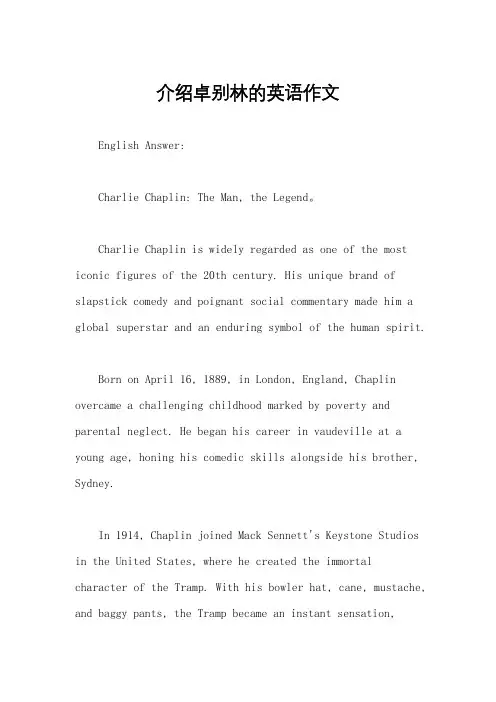
介绍卓别林的英语作文English Answer:Charlie Chaplin: The Man, the Legend。
Charlie Chaplin is widely regarded as one of the most iconic figures of the 20th century. His unique brand of slapstick comedy and poignant social commentary made him a global superstar and an enduring symbol of the human spirit.Born on April 16, 1889, in London, England, Chaplin overcame a challenging childhood marked by poverty and parental neglect. He began his career in vaudeville at a young age, honing his comedic skills alongside his brother, Sydney.In 1914, Chaplin joined Mack Sennett's Keystone Studios in the United States, where he created the immortal character of the Tramp. With his bowler hat, cane, mustache, and baggy pants, the Tramp became an instant sensation,embodying the struggles and resilience of the working class.Chaplin's films transcended mere entertainment. He used his platform to advocate for social justice and human rights. Films such as "The Kid" (1921), "Modern Times" (1936), and "The Great Dictator" (1940) showcased his keen eye for social ills and his unwavering belief in the powerof compassion.Beyond his acting, Chaplin was a prolific writer, director, and composer. He pioneered innovative cinematic techniques, including the use of close-ups and trick photography. His films were a testament to his artistic vision and his ability to connect with audiences on an emotional level.In his later years, Chaplin faced political persecution during the McCarthy era. He was accused of communist sympathies and was forced to leave the United States. He eventually settled in Switzerland, where he continued to work until his death on December 25, 1977.Charlie Chaplin's legacy lives on. His films continue to entertain and inspire audiences worldwide. He is remembered as a master of comedy, a social activist, and a true cinematic icon. His work remains a timeless testament to the human condition and the enduring power of art.Chinese Answer:查理·卓别林,一个人,一个传奇。
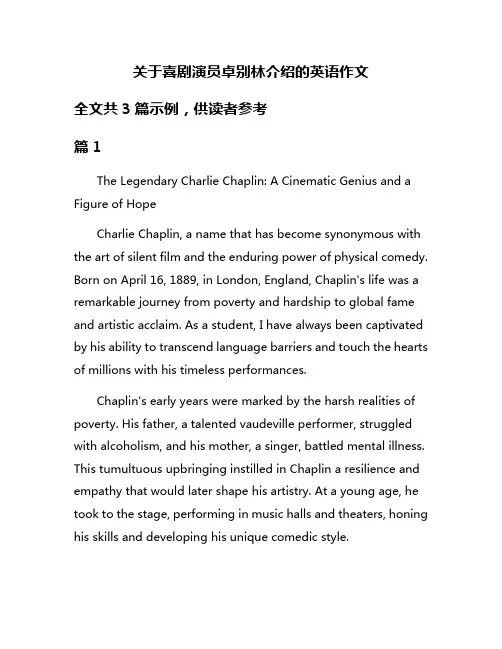
关于喜剧演员卓别林介绍的英语作文全文共3篇示例,供读者参考篇1The Legendary Charlie Chaplin: A Cinematic Genius and a Figure of HopeCharlie Chaplin, a name that has become synonymous with the art of silent film and the enduring power of physical comedy. Born on April 16, 1889, in London, England, Chaplin's life was a remarkable journey from poverty and hardship to global fame and artistic acclaim. As a student, I have always been captivated by his ability to transcend language barriers and touch the hearts of millions with his timeless performances.Chaplin's early years were marked by the harsh realities of poverty. His father, a talented vaudeville performer, struggled with alcoholism, and his mother, a singer, battled mental illness. This tumultuous upbringing instilled in Chaplin a resilience and empathy that would later shape his artistry. At a young age, he took to the stage, performing in music halls and theaters, honing his skills and developing his unique comedic style.It was during his time with the Fred Karno comedy troupe that Chaplin truly found his niche. His iconic character, the "Little Tramp," was born – a downtrodden yet endearing figure, clad in a tattered suit, oversized shoes, and a distinctive mustache. This character embodied the struggles and aspirations of the common man, resonating with audiences across the globe.Chaplin's arrival in Hollywood in 1913 marked the beginning of a legendary career that would span decades. His first film appearance in the 1914 comedy short "Making a Living" was a modest start, but it laid the foundation for his meteoric rise. With each subsequent film, Chaplin's reputation grew, and his popularity soared.One of his most celebrated works, "The Kid," released in 1921, showcased Chaplin's remarkable ability to blend humor and pathos. The film's poignant storyline, which follows the Little Tramp's chance encounter with an abandoned child, tugged at the heartstrings of audiences worldwide. Chaplin's performance was a masterclass in physical comedy, evoking laughter and tears in equal measure.As the era of silent films drew to a close, Chaplin seamlessly transitioned into the world of talkies with his 1940 masterpiece, "The Great Dictator." This satirical comedy, in which he playedboth a Jewish barber and the dictator Adenoid Hynkel, was a daring and bold statement against the rise of fascism and antisemitism. Chaplin's brilliant parody of Adolf Hitler and his poignant plea for peace and humanity resonated profoundly, cementing his status as a true artist and social commentator.Throughout his career, Chaplin remained a fierce advocate for artistic freedom and social justice. His films often tackled complex themes, exploring the plight of the working class, the dangers of unchecked power, and the importance of human dignity. His unwavering commitment to his craft and his principles earned him both admiration and criticism, but he never wavered in his pursuit of truth and artistic expression.Perhaps Chaplin's most enduring legacy lies in his ability to bring joy and laughter to audiences around the world. His films transcended cultural and linguistic barriers, connecting with people on a universal level. The Little Tramp, with his endearing clumsiness and unwavering optimism, became a symbol of hope and resilience, reminding us that even in the darkest of times, there is room for laughter and humanity.As a student, I am constantly reminded of the power of art to inspire, educate, and unite. Chaplin's life and work serve as a testament to the transformative potential of cinema and theenduring impact of a single individual's vision. His films continue to captivate audiences, inspiring new generations of artists and thinkers to embrace their creativity and use their voices to bring about positive change.In a world often consumed by conflict and division, Chaplin's message of unity and compassion remains as relevant as ever. His ability to find humor in the most trying circumstances and to shine a light on the struggles of the marginalized has left an indelible mark on the cinematic landscape and the collective consciousness of society.As I reflect on Chaplin's extraordinary journey, I am filled with awe and admiration. From his humble beginnings to his status as a cultural icon, his life serves as a powerful reminder of the transformative power of perseverance, dedication, and artistic vision. Chaplin's legacy extends far beyond the realm of cinema; it is a testament to the enduring spirit of creativity, resilience, and the human capacity for empathy and understanding.In the end, Charlie Chaplin was more than just a comedic genius – he was a visionary artist, a social commentator, and a beacon of hope for countless individuals around the world. His films continue to inspire and delight, reminding us of theuniversal language of laughter and the unifying power of art. As a student, I am grateful for the opportunity to study and appreciate his extraordinary body of work, and I am forever inspired by his unwavering commitment to using his art as a catalyst for positive change.篇2The Immortal Tramp: Charlie Chaplin, the Comedy LegendCharlie Chaplin is a true icon of the entertainment world, a comedic genius whose legacy has transcended generations and captured the hearts of audiences worldwide. As a student of film and history, I have been captivated by Chaplin's remarkable life story and his unparalleled contribution to the art of comedy.Born on April 16, 1889, in London, England, Chaplin's early years were marked by poverty and hardship. His childhood was a tumultuous one, with his mother's mental illness and his father's absence forcing him and his brother to endure the harsh realities of life in the slums. It was during these formative years that Chaplin developed his keen observational skills and a deep empathy for the downtrodden, traits that would later become the cornerstone of his iconic character, the Little Tramp.Chaplin's foray into the world of entertainment began at a young age, as he took to the stage in various music hall performances to support his family. It was during these early years that his natural talent for physical comedy and mime was honed, laying the foundation for the legendary career that was to follow.In 1914, Chaplin's life took a pivotal turn when he signed with the Keystone Film Company and made his debut in the world of silent films. It was here that the iconic Little Tramp character was born – a lovable, downtrodden vagabond with a small mustache, baggy pants, and a cane, who captured the hearts of audiences with his endearing charm and poignant social commentary.Chaplin's genius lay in his ability to blend slapstick comedy with poignant social commentary, using his Little Tramp character as a vehicle to explore the complexities of human existence and the struggles of the working class. Films like "The Kid" (1921), "The Gold Rush" (1925), and "The Circus" (1928) not only showcased his impeccable timing and physical prowess but also his deep understanding of human emotions and the power of pathos.One of Chaplin's most celebrated works, "Modern Times" (1936), was a scathing critique of industrialization and the dehumanization of the working class. Through the lens of the Little Tramp, Chaplin masterfully satirized the harsh realities of the modern world while simultaneously eliciting laughter and empathy from his audience. It was a testament to his ability to seamlessly blend comedy with social commentary, a feat that few have been able to match.Beyond his comedic prowess, Chaplin was also a visionary filmmaker who pushed the boundaries of the art form. He was a pioneer in the use of camera techniques, editing, and storytelling, creating a cinematic language that was both innovative and influential. His films were not mere entertainments but works of art that challenged societal norms and explored the depths of the human condition.Chaplin's impact on the world of comedy is immeasurable. He inspired generations of comedians and filmmakers, from Buster Keaton to Jacques Tati, and his influence can still be seen in contemporary comedic works. His ability to transcend language and cultural barriers, to evoke laughter and tears with equal ease, is a testament to the universal appeal of his art.But Chaplin's legacy extends beyond the realm of entertainment. He was a vocal advocate for social justice and a champion of the underdog, using his platform to raise awareness about the plight of the working class and the need for political and social reform. His films were not mere escapism but a mirror held up to society, reflecting the harsh realities of the time while offering a glimmer of hope and resilience.In my studies, I have been particularly drawn to Chaplin's unwavering commitment to his craft and his uncompromising artistic vision. Despite facing numerous obstacles, including political persecution and financial struggles, he remained steadfast in his pursuit of artistic excellence, refusing to compromise his values or dilute his message.As a student of film and comedy, I am constantly in awe of Chaplin's ability to evoke such a wide range of emotions through his minimalist approach. His performances were a masterclass in physical comedy, with every gesture, every movement, every facial expression meticulously crafted to elicit laughter and pathos. His ability to convey complex emotions without uttering a single word is a testament to his profound understanding of the human condition and the power of non-verbal communication.Chaplin's influence extends far beyond the realm of film and comedy. He was a true Renaissance man, a multifaceted artist who excelled in various disciplines, from composing music to writing and directing. His legacy serves as an inspiration to artists of all kinds, reminding us of the power of creativity, perseverance, and unwavering dedication to one's craft.In today's world, where laughter and joy seem fleeting, Chaplin's work serves as a beacon of hope and a reminder of the healing power of comedy. His films continue to resonate with audiences across generations, transcending cultural and linguistic barriers, and reminding us of the universality of human experiences.As a student, I am deeply grateful for the opportunity to study and appreciate the work of such a legendary figure. Chaplin's life and art have taught me invaluable lessons about resilience, creativity, and the power of laughter to bring people together. His legacy inspires me to approach my own pursuits with the same passion, dedication, and unwavering commitment to artistic excellence.In conclusion, Charlie Chaplin was more than just a comedian; he was a visionary artist, a social commentator, and a true humanitarian. His impact on the world of entertainment andbeyond cannot be overstated. Through his iconic Little Tramp character, he gave voice to the voiceless and shined a light on the struggles of the working class, reminding us of the enduring power of laughter and empathy. As I continue my studies and pursue my own creative endeavors, Chaplin's life and work will forever serve as a guiding light, inspiring me to push boundaries, challenge societal norms, and use my art as a force for positive change.篇3The Tramp Who Made the World Laugh: A Look at the Life and Legacy of Charlie ChaplinWhen you hear the name Charlie Chaplin, one image immediately comes to mind - the iconic little tramp with a bowler hat, bamboo cane, and awkward waddle. With his quirky mustache and ill-fitting clothes, this character created an unforgettable presence on the silent film screen. However, behind the comedic genius that brought smiles to millions was a complex man whose life was marked by immense talent, hardship, controversy, and an unwavering passion for his art.Born on April 16, 1889 in London, Charlie Chaplin entered the world in incredibly humble circumstances. His childhood wasclouded by the dark realities of poverty - his father was an unpredictable artist who eventually abandoned the family, while his mother struggled with mental illness and was committed to an asylum when Charlie was just nine years old. With his family life in shambles, the young Chaplin turned to entertaining on the streets of London as a means of survival, singing songs and performing comedy sketches to earn a few coins.It was this harsh upbringing that shaped Chaplin's comedic sensibilities and brought depth to the iconic "Little Tramp" character he later manifested on the screen. The tramp, dressed in tattered clothes and down on his luck, resonated with audiences as he became a symbol of the struggles faced by the impoverished and the perpetual underdog who kept bouncing back from adversity. As film historian Mark Cousins puts it, "The tramp is still magic because he represents human hopes born out of poverty and pain."Chaplin's meteoric rise in the entertainment world began with his introduction to vaudeville at age 10, where he toured with comic opera troupes and quickly developed his skills in physical comedy and pantomime. It was the perfect launchpad for his transition to silent films in 1914, as he joined the KeystoneFilm Company and starred in comedic shorts showcasing his gift for slapstick humor and impeccable comedic timing.However, it wasn't until 1915 that Chaplin stepped into the role that would elevate him to international stardom – his first appearance as the lovable Little Tramp in the film "The Tramp." With his instantly recognizable costume, the little fellow with the toothbrush mustache and signature walk captivated audiences around the world with his ability to find humor and tenderness even in the direst of circumstances. Chaplin's skill in combining slapstick with pantomime and subtle gestures created a depth to his comedy that transcended language barriers and cultural divides.Over the next 25 years, Chaplin churned out dozens of iconic films, each one a masterpiece of physical comedy and social commentary. From "The Kid" (1921), where he played a tendering father figure to an abandoned child, to the satirical "The Great Dictator" (1940) which boldly mocked Adolf Hitler and the rise of Nazism, Chaplin used his comedic talents to explore the human condition and shine a light on societal issues that often went unspoken.Perhaps his most celebrated work was "Modern Times" (1936), a brilliant commentary on the dehumanizing effects ofindustrialization and mass production. With scenes of Chaplin being literally swallowed by the machinations of a factory assembly line, the film captured the anxieties of a rapidly modernizing world while still finding moments of pure hilarity.Beyond his prodigious body of work on the screen, Chaplin was a trailblazer who fought for artistic control and freedom of expression at a time when studios tried to reign in creative talents. His founding of United Artists in 1919, alongside Douglas Fairbanks and others, gave him an independence rarely afforded to filmmakers of that era. Chaplin could craft his films with minimal oversight, infusing them with bold political messages and social critiques that would have been unthinkable under the tight control of major studios.Yet, Chaplin's life was not without immense controversy and hardship. His personal life, marked by multiple marriages and paternity scandals, was often front-page news. Additionally, his left-leaning political views, connections to communist sympathizers, and pacifist stances during World War II led to him being labeled a subversive by the U.S. government during the paranoia of the McCarthyism era. This culminated in Chaplin being denied re-entry into the United States in 1952 while traveling abroad – an event that left the 63-year old iconessentially exiled from the country that had brought him lasting fame.Chaplin spent his final 25 years living as an ex-patriot in Switzerland, occasionally appearing on television and receiving a lifetime achievement award from the Academy in 1972. Even in his twilight years, the "Little Tramp" commanded immense adoration from fans. Upon his death in 1977 at age 88, the world mourned a true cinematic legend and an artist who had brought incomparable joy and laughter to countless lives.Looking at Chaplin's profound legacy nearly 50 years after his passing, it's clear that his impact extends far beyond the comedic realms of cinema. Through the Little Tramp, he gave the world an enduring symbol representing the resilience and hopefulness of the human spirit in the face of adversity. At a time when silent films were considered a fleeting novelty, Chaplin's genius elevated the artform and set a benchmark for physical comedy and storytelling that few have matched.Equally vital was Chaplin's role as a social commentator – his films bravely held a mirror up to society, satirizing authoritarianism, inequality, and the ethical pitfalls of modernity in a way that still resonates today. German poet and playwright Bertolt Brecht spoke for many when he described the brillianceof Chaplin's craft: "The man lie laughed at was capital itself –social injustice, false ethics, hypocrisy. He made a ceaseless battle against this and on behalf of man's laughter."So while the Little Tramp may have been a man of few words, his message of hope, perseverance, and using humor as a tool for social commentary still rings loudly in the 21st century. Whether falling into an ingenious slapstick routine or boldly mocking the forces of fascism and oppression, Charlie Chaplin and his iconic character remain timeless symbols of joy, community, and the transformative power of comedy.。
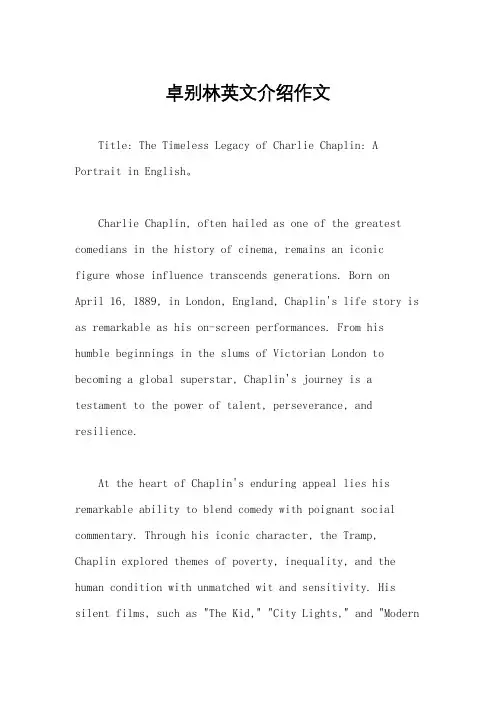
卓别林英文介绍作文Title: The Timeless Legacy of Charlie Chaplin: A Portrait in English。
Charlie Chaplin, often hailed as one of the greatest comedians in the history of cinema, remains an iconicfigure whose influence transcends generations. Born onApril 16, 1889, in London, England, Chaplin's life story is as remarkable as his on-screen performances. From his humble beginnings in the slums of Victorian London to becoming a global superstar, Chaplin's journey is a testament to the power of talent, perseverance, and resilience.At the heart of Chaplin's enduring appeal lies his remarkable ability to blend comedy with poignant social commentary. Through his iconic character, the Tramp, Chaplin explored themes of poverty, inequality, and the human condition with unmatched wit and sensitivity. His silent films, such as "The Kid," "City Lights," and "ModernTimes," continue to captivate audiences worldwide, despite being nearly a century old.Chaplin's genius extended beyond his skills as an actor and director; he was also a visionary artist who revolutionized the language of cinema. His pioneering use of slapstick comedy, visual gags, and expressive mime set new standards for cinematic storytelling and paved the way for future generations of filmmakers. Even in an era dominated by talkies, Chaplin's silent films retained their charm and relevance, proving that true artistry transcends technological advancements.Beyond his contributions to cinema, Chaplin was also a passionate advocate for social justice and human rights. In the midst of global upheaval, he used his platform to speak out against tyranny, fascism, and oppression. His satirical masterpiece, "The Great Dictator," released in 1940, remains a powerful indictment of authoritarianism and a rallying cry for freedom and democracy.Despite facing personal and professional challengesthroughout his life, including controversies surrounding his political beliefs and tumultuous relationships,Chaplin's legacy endures as a testament to the transformative power of laughter and compassion. His timeless characters continue to evoke laughter and empathy in audiences of all ages, reminding us of the universal truths that bind us together as human beings.In conclusion, Charlie Chaplin's contributions to the world of cinema and beyond are immeasurable. His iconic characters, brilliant performances, and profound insights into the human condition have left an indelible mark on our collective consciousness. As we continue to revisit his timeless films and celebrate his enduring legacy, let us remember Charlie Chaplin not only as a comedic genius but also as a visionary artist and a champion of the human spirit.。
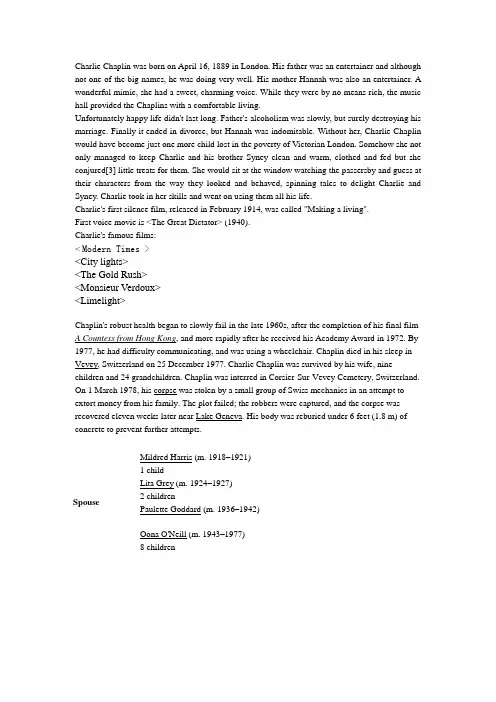
Charlie Chaplin was born on April 16, 1889 in London. His father was an entertainer and although not one of the big names, he was doing very well. His mother Hannah was also an entertainer. A wonderful mimic, she had a sweet, charming voice. While they were by no means rich, the music hall provided the Chaplins with a comfortable living.Unfortunately happy life didn't last long. Father's alcoholism was slowly, but surely destroying his marriage. Finally it ended in divorce, but Hannah was indomitable. Without her, Charlie Chaplin would have become just one more child lost in the poverty of Victorian London. Somehow she not only managed to keep Charlie and his brother Syney clean and warm, clothed and fed but she conjured[3] little treats for them. She would sit at the window watching the passersby and guess at their characters from the way they looked and behaved, spinning tales to delight Charlie and Syney. Charlie took in her skills and went on using them all his life.Charlie's first silence film, released in February 1914, was called "Making a living".First voice movie is <The Great Dictator> (1940).Charlie's famous films:<Modern Times ><City lights><The Gold Rush><Monsieur Verdoux><Limelight>Chaplin's robust health began to slowly fail in the late 1960s, after the completion of his final film A Countess from Hong Kong, and more rapidly after he received his Academy Award in 1972. By 1977, he had difficulty communicating, and was using a wheelchair. Chaplin died in his sleep in Vevey, Switzerland on 25 December 1977. Charlie Chaplin was survived by his wife, nine children and 24 grandchildren. Chaplin was interred in Corsier-Sur-Vevey Cemetery, Switzerland. On 1 March 1978, his corpse was stolen by a small group of Swiss mechanics in an attempt to extort money from his family. The plot failed; the robbers were captured, and the corpse was recovered eleven weeks later near Lake Geneva. His body was reburied under 6 feet (1.8 m) of concrete to prevent further attempts.Spouse Mildred Harris (m. 1918–1921) 1 childLita Grey (m. 1924–1927)2 childrenPaulette Goddard (m. 1936–1942)Oona O'Neill (m. 1943–1977)8 childrenChild Birth Death Chaplin'sageat time ofbirthMother GrandchildrenNorman Spencer Chaplin 7 July 191910 July191930MildredHarrisCharles Spencer Chaplin, Jr.[125]5 May 192520 March196836Lita GreySusan Maree Chaplin(b 1959)Sydney Earle Chaplin 31 March19263 March200936Stephan Chaplin (b19xx)Carol Ann Barry Chaplin (Disputed)[126]2 October194354 Joan Barry UnknownGeraldine Leigh Chaplin 31 July 1944 55OonaO'Neill Shane Saura Chaplin (b 1974)Oona Castilla Chaplin (b 1986)Michael John Chaplin 7 March194656Kathleen Chaplin (b.1975)Dolores Chaplin (b.1979)Carmen Chaplin (b19xx)George Chaplin (b19xx)Josephine Hannah Chaplin 28 March194959 Julien Ronet (b. 1980)Victoria Chaplin 19 May 1951 62 Aurélia Thiérrée (b. 1971)James Thiérrée (b. 1974)Eugene Anthony Chaplin 23 August195364Kiera Chaplin (b.1982)Jane Cecil Chaplin 23 May 1957 68 Orson Salkind (b. 1986)Osceola Salkind (b. 1994)Annette Emily Chaplin 3 December195970Christopher JamesChaplin6 July 1962 73。
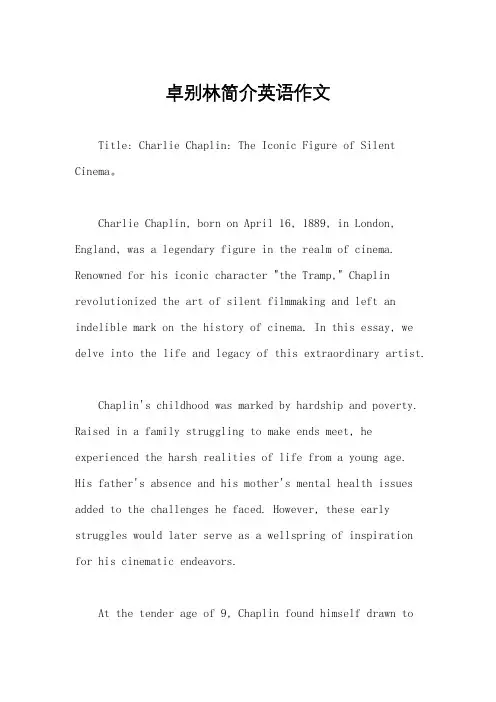
卓别林简介英语作文Title: Charlie Chaplin: The Iconic Figure of Silent Cinema。
Charlie Chaplin, born on April 16, 1889, in London, England, was a legendary figure in the realm of cinema. Renowned for his iconic character "the Tramp," Chaplin revolutionized the art of silent filmmaking and left an indelible mark on the history of cinema. In this essay, we delve into the life and legacy of this extraordinary artist.Chaplin's childhood was marked by hardship and poverty. Raised in a family struggling to make ends meet, he experienced the harsh realities of life from a young age. His father's absence and his mother's mental health issues added to the challenges he faced. However, these early struggles would later serve as a wellspring of inspiration for his cinematic endeavors.At the tender age of 9, Chaplin found himself drawn tothe world of performing arts. He joined a clog-dancing troupe, where he honed his skills as a performer. Thisearly exposure to the stage laid the foundation for his future career in entertainment.Chaplin's breakthrough came when he was discovered by film producer Mack Sennett, who offered him a contract with Keystone Studios in 1913. It was here that Chaplin created his iconic Tramp character, with his bowler hat, cane, and distinctive mustache. The Tramp, with his endearing charm and resilience in the face of adversity, captured thehearts of audiences worldwide.Throughout his career, Chaplin not only entertained audiences but also used his platform to address social and political issues of the time. Films such as "The Kid" (1921) and "Modern Times" (1936) tackled themes of poverty, inequality, and the dehumanizing effects of industrialization. Chaplin's unique blend of humor and pathos allowed him to convey profound messages while entertaining audiences.Despite his immense popularity, Chaplin's personal life was marked by controversy. His marriages, affairs, and political views often made headlines and drew both admiration and criticism. In the 1940s, Chaplin's outspoken criticism of fascism and his alleged ties to communism led to a backlash in the United States, ultimately resulting in his exile from the country.However, Chaplin's exile did not diminish his legacy. He continued to make films in Europe, including classics like "Limelight" (1952) and "A King in New York" (1957). In 1972, he received an honorary Academy Award for his "incalculable effect in making motion pictures the art form of this century."Charlie Chaplin's influence extends far beyond the realm of cinema. His timeless humor, poignant storytelling, and commitment to social justice have left an indelible mark on the world. Even today, his films continue to captivate audiences of all ages, proving that the tramp with the bowler hat remains as relevant as ever. As we reflect on Chaplin's life and legacy, we are reminded ofthe power of art to transcend boundaries and touch the hearts of millions.。
查理卓别林的英文介绍English:Charles Chaplin, also known as Charlie Chaplin, was an iconic English actor, comedian, and filmmaker who became a worldwide sensation for his silent film performances during the early 20th century. Born in London in 1889, Chaplin's impoverished childhood and early experiences in the performing arts laid the foundation for his future success. He rose to fame with his character "the Tramp," a lovable and bumbling vagrant with a distinctive mustache and bowler hat. Chaplin's comedic talents and contributions to the film industry earned him numerous accolades and recognition, including an honorary Academy Award for his outstanding and unique talents in the world of cinema. His films, such as "The Kid," "City Lights," and "Modern Times," are still celebrated as cinematic masterpieces and continue to influence filmmakers and actors to this day. Despite facing personal and professional challenges, Chaplin's legacy as a pioneering figure in entertainment endures, and he is remembered as one of the greatest and most influential personalities in the history of film and comedy.中文翻译:查理卓别林,也被称为查理·卓别林,是一位标志性的英国演员,喜剧演员和电影制片人,在20世纪初因其无声电影表演而成为了全球轰动。
卓别林介绍英语作文简单Charlie Chaplin, also known as Sir Charles Spencer Chaplin, was a legendary English actor, comedian, and filmmaker. He was born on April 16, 1889, in London, England. Chaplin is considered one of the most influential figures in the history of the film industry.Chaplin's childhood was marked by poverty and hardship. His parents separated when he was young, and his mother struggled to make ends meet. Chaplin's early experiences of poverty and social inequality would later become recurring themes in his films.Chaplin's career in the entertainment industry began when he joined a juvenile dance troupe called the Eight Lancashire Lads. He later worked as a comedian in music halls, where he honed his comedic skills and developed his iconic character, "The Tramp." The Tramp, with his distinctive costume of a bowler hat, cane, and oversized shoes, became Chaplin's most recognizable persona.In 1914, Chaplin made his debut in the film industrywith the silent film "Making a Living." He quickly gained popularity with his physical comedy and slapstick humor. Some of his most famous films include "The Kid" (1921), "City Lights" (1931), and "Modern Times" (1936). Chaplin's films often combined comedy with social commentary, addressing issues such as poverty, industrialization, and the struggles of the working class.Chaplin's silent films were accompanied by his own musical compositions, and he later transitioned into making sound films. However, his career faced challenges in the 1940s due to his political views. Chaplin was known for his left-leaning political beliefs and was accused of being a communist sympathizer during the era of McCarthyism. As a result, he faced scrutiny and was eventually forced toleave the United States and settle in Switzerland.Despite the controversies surrounding his personal life, Chaplin's contributions to the film industry cannot be overlooked. He was a pioneer in the development of comedyand brought laughter to millions of people worldwide. His physical comedy, expressive acting, and ability to connect with audiences transcended language barriers.In recognition of his achievements, Chaplin received numerous awards and honors throughout his career. He was awarded an honorary Academy Award in 1972 for his lifetime contributions to cinema. In 1975, Queen Elizabeth II knighted him, and he became Sir Charles Spencer Chaplin.Charlie Chaplin's legacy continues to inspire and entertain audiences to this day. His films remain timeless classics, and his impact on the world of cinema is undeniable. Chaplin's ability to use humor to shed light on social issues and connect with people from all walks oflife is a testament to his genius and enduring influence.。
卓别林事迹作文英文Charlie Chaplin, the legendary silent film actor, was known for his comedic genius and iconic character, the Tramp. His life was filled with extraordinary achievements and unforgettable moments.One of Chaplin's most notable achievements was his ability to captivate audiences without uttering a single word. Through his physical comedy and expressive gestures, he was able to convey complex emotions and tell compelling stories. His silent films, such as "The Kid" and "City Lights," continue to be cherished and admired by audiences worldwide.Chaplin's talent extended beyond acting. He was also a skilled director, writer, and composer. He had a keen eye for storytelling and a knack for creating memorable characters. His films often tackled social and political issues, using humor to shed light on the human condition. Chaplin's masterpiece, "Modern Times," satirized thedehumanizing effects of industrialization, while "The Great Dictator" boldly criticized Adolf Hitler and fascism.Despite his immense success, Chaplin faced numerous challenges throughout his life. He was born into poverty and experienced a difficult childhood. His father's absence and his mother's mental illness forced him to fend for himself from a young age. These early struggles undoubtedly shaped his resilience and determination to succeed.Chaplin's personal life was also marked by controversy. He had a series of tumultuous relationships and faced accusations of moral and political misconduct. However, his undeniable talent and contribution to the film industry overshadowed these controversies, and he remains an influential figure to this day.Chaplin's impact on popular culture cannot be overstated. His distinctive bowler hat, cane, and mustache have become iconic symbols of comedy. His physical comedy routines, such as the famous "tightrope dance" in "The Circus," continue to inspire and entertain audiences.Chaplin's influence can be seen in the work of countless comedians and filmmakers who have followed in his footsteps.In conclusion, Charlie Chaplin's life and career were filled with remarkable achievements and unforgettable moments. His ability to connect with audiences through physical comedy and his unique storytelling style set him apart as a true cinematic genius. Despite facing personal and professional challenges, Chaplin's legacy continues to resonate and inspire generations of artists and entertainers.。
Introduction of Chaplin's lifeIn 1889, Chaplin was born in a slum area of London, his parents were music hall actors. His father had died, his mother suffers from mental illness, childhood he was homeless, He lived in the orphanage, he was to be groom and hawker. At the age of 14, Chaplin joined the mobile group, throughout the UK. At the age of 19, he became a famous actor, and with the mission to Europe, the United States and other performances. In 1913 he went to the United States, began working in the movie business, and in 1914 in the film "Venice racing down "created a tragedy "Charlotte" little people, and the special attire tramp image around the world for 70 years, enduring.Throughout his life Chaplin starred in more than 80 films, some of his representative works, such as "peace", "dog career", "the kid", "gold rush", "city lights", "modern times", "big brother" and other works, These works sympathy for the poor and ridicule the rich . His works unique style, comedy is very popular, but also makes people happy after the bitter, have sympathy for the oppressed people.Chaplin has lived in the United States for nearly 40 years, after the Second World War, due to McCarthyism's in US. In 1952 he was filled with resentment, leaving the United States returned to England with his wife and son. After then, he settled in Switzerland. a long time.December 25, 1977 morning 4 when, Charlie Chaplin humor master world famous died, at the age of 88.One of his representative works"The Great Dictator" is Chaplin's most successful film, but also his first sound film. This is the anti war theme movie he directed, shot during the Second World War, describes a suffered cruel persecution of Jews, and a rule the world dictator. Chaplinimitates the fascist leader Hitler, expressed contempt for the Nazi dictator, in the end, lasting 7 minutes of speech is the most beautiful discourse in the life of Chaplin ! In times of war, inspire people!However, the film never won any awards, this is a the most unfair case in the world film's history . Despite, At the 2002 Cannes Film Festival in France, the new copy again released film re produced, and it attracted more than 200000 people view shadow boom.His contribution to the film industryChaplin is the greatest critical realism film artists in twentieth Century, most famous comedian in the world. His the most prominent contribution is that he put the vulgar farce rise to the critical realism artistic class. His unique style of comedy performances and irony, which sharply criticized the evil of the capitalist society, and show the fateful struggle, for happy life and beautiful ideal never yield in spite of reverses pursuit, let the audience to tears in laughter. Chaplin wrote a glorious page in the Hollywood film history and the world film history.。
Curriculum VitaeIntroductionName: Charles ChaplinSex: manBirth Date: 16 April 1889Death Date: 25 December 1977Place of Birth: LondonPlace of Death: SwitzerlandNationality: The United KingdomProfession: Comic actor Film directorAchievement: Oscar Lifetime Achievement AwardThe British Empire Medal The WearerLifetimeHis working life in entertainment spanned over 75 years, from the Victorian stage and the Music Hall in the United Kingdom as a child performer, until close to his death at the age of 88. Hishigh-profile public and private life encompassed both adulation and controversy. Chaplin's identification with the left ultimately forced him to resettle in Europe during the McCarthy era in the early 1950s. Chaplin's robust health began to slowly fail in the late 1960s, after the completion of his final film A Countess from Hong Kong,and more rapidly after he received his Academy Award in 1972. Chaplin died in his sleep in Vevey, Switzerland on Christmas Day 1977.Classic FiguresA tramp in baggy trousers and a bowler hatRepresentative WorksCity Lights The Gold RushModern Times The Great DictatorEvaluationone of the best-known film stars in the world before the end of the First World Warone of the most creative and influential personalities of the silent-film era. Just like George Bernard Shaw called him "the only genius to come out of the movie industry".。
Introduction of Chaplin's life
In 1889, Chaplin was born in a slum area of London, his parents were music hall actors. His father had died, his mother suffers from mental illness, childhood he was homeless, He lived in the orphanage, he was to be groom and hawker. At the age of 14, Chaplin joined the mobile group, throughout the UK. At the age of 19, he became a famous actor, and with the mission to Europe, the United States and other performances. In 1913 he went to the United States, began working in the movie business, and in 1914 in the film "Venice racing down "created a tragedy "Charlotte" little people, and the special attire tramp image around the world for 70 years, enduring.
Throughout his life Chaplin starred in more than 80 films, some of his representative works, such as "peace", "dog career", "the kid", "gold rush", "city lights", "modern times", "big brother" and other works, These works sympathy for the poor and ridicule the rich . His works unique style, comedy is very popular, but also makes people happy after the bitter, have sympathy for the oppressed people.
Chaplin has lived in the United States for nearly 40 years, after the Second World War, due to McCarthyism's in US. In 1952 he was filled with resentment, leaving the United States returned to England with his wife and son. After then, he settled in Switzerland. a long time.
December 25, 1977 morning 4 when, Charlie Chaplin humor master world famous died, at the age of 88.
One of his representative works
"The Great Dictator" is Chaplin's most successful film, but also his first sound film. This is the anti war theme movie he directed, shot during the Second World War, describes a suffered cruel persecution of Jews, and a rule the world dictator. Chaplin
imitates the fascist leader Hitler, expressed contempt for the Nazi dictator, in the end, lasting 7 minutes of speech is the most beautiful discourse in the life of Chaplin ! In times of war, inspire people!
However, the film never won any awards, this is a the most unfair case in the world film's history . Despite, At the 2002 Cannes Film Festival in France, the new copy again released film re produced, and it attracted more than 200000 people view shadow boom.
His contribution to the film industry
Chaplin is the greatest critical realism film artists in twentieth Century, most famous comedian in the world. His the most prominent contribution is that he put the vulgar farce rise to the critical realism artistic class. His unique style of comedy performances and irony, which sharply criticized the evil of the capitalist society, and show the fateful struggle, for happy life and beautiful ideal never yield in spite of reverses pursuit, let the audience to tears in laughter. Chaplin wrote a glorious page in the Hollywood film history and the world film history.。